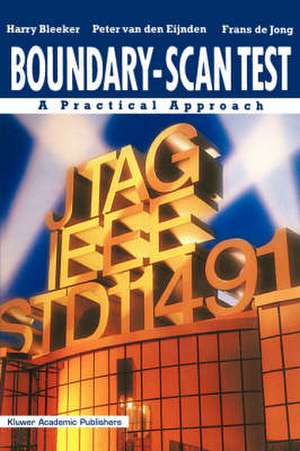Boundary-Scan Test: A Practical Approach
Autor Harry Bleeker, Peter van den Eijnden, Frans de Jongen Limba Engleză Hardback – 30 dec 1992
| Toate formatele și edițiile | Preț | Express |
|---|---|---|
| Paperback (1) | 984.50 lei 6-8 săpt. | |
| Springer Us – 5 oct 2012 | 984.50 lei 6-8 săpt. | |
| Hardback (1) | 989.96 lei 6-8 săpt. | |
| Springer Us – 30 dec 1992 | 989.96 lei 6-8 săpt. |
Preț: 989.96 lei
Preț vechi: 1237.46 lei
-20% Nou
Puncte Express: 1485
Preț estimativ în valută:
189.44€ • 202.57$ • 157.94£
189.44€ • 202.57$ • 157.94£
Carte tipărită la comandă
Livrare economică 17 aprilie-01 mai
Preluare comenzi: 021 569.72.76
Specificații
ISBN-13: 9780792392965
ISBN-10: 0792392965
Pagini: 225
Ilustrații: XVI, 225 p.
Dimensiuni: 155 x 235 x 21 mm
Greutate: 0.5 kg
Ediția:1993
Editura: Springer Us
Colecția Springer
Locul publicării:New York, NY, United States
ISBN-10: 0792392965
Pagini: 225
Ilustrații: XVI, 225 p.
Dimensiuni: 155 x 235 x 21 mm
Greutate: 0.5 kg
Ediția:1993
Editura: Springer Us
Colecția Springer
Locul publicării:New York, NY, United States
Public țintă
ResearchDescriere
The ever-increasing miniaturization of digital electronic components is hampering the conventional testing of Printed Circuit Boards (PCBs) by means of bed-of-nails fixtures. Basically this is caused by the very high scale of integration of ICs, through which packages with hundreds of pins at very small pitches of down to a fraction of a millimetre, have become available. As a consequence the trace distances between the copper tracks on a printed circuit board cmne down to the same value. Not only the required small physical dimensions of the test nails have made conventional testing unfeasible, but also the complexity to provide test signals for the many hundreds of test nails has grown out of limits. Therefore a new board test methodology had to be invented. Following the evolution in the IC test technology. Boundary-Scan testing hm; become the new approach to PCB testing. By taking precautions in the design of the IC (design for testability), testing on PCB level can be simplified 10 a great extent. This condition has been essential for the success of the introduction of Boundary-Sc,m Test (BST) at board level.
Cuprins
List of Figures. Preface. 1. PCB Testing. 2. The Boundary-Scan Test Standard. 3. Hardware Test Innovations. 4. BST Design Languages. 5. PCB Test Strategy Backgrounds. 6. Management Aspects. Appendix. Glossary. References. Index.
Recenzii
`I recommend this book for the following audience in the field of digital design: advanced undergraduate and graduate students, who are interested in testing digital systems and are looking for an up-to-date course in design for testability; practising engineers interested in incorporating modern techniques for improving testability into their designs; and design managers who are looking for ways to improve factory profitability and return on investments. The book will appeal especially to practising VLSI and ASIC designers, and I recommend it to them highly.'
Engineering Applications of Artifical Intelligence, 7:1
' In summary, this text is a useful and readable description of the application and use of boundary-scan. It is also a useful addition to previous boundary-scan publication, and complementary to more recent. I thoroughly recommend this book. ' Microprocessors and Microsystems 17:5 1993
Engineering Applications of Artifical Intelligence, 7:1
' In summary, this text is a useful and readable description of the application and use of boundary-scan. It is also a useful addition to previous boundary-scan publication, and complementary to more recent. I thoroughly recommend this book. ' Microprocessors and Microsystems 17:5 1993





















